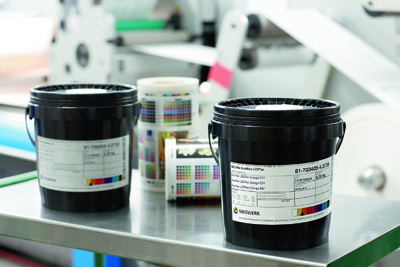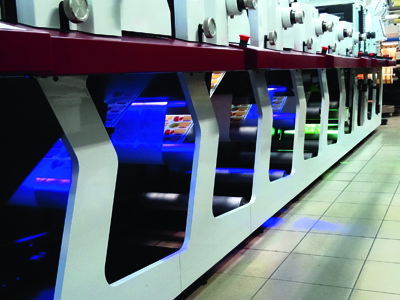Narrow web label press with LED curing at KDS in Sulejówek near Warsaw, Poland
Sean Smyth takes a look at the science behind UV inks, how their manufacturers are working to improve ink performance and how curing units are evolving to facilitate their use in the industry.
Flexo printers have three choices in the ink they use; water based, solvent based or UV curing, which happens to be the ink of choice in narrow web labels and cartons. UV curing inks and varnishes can deliver quality improvements over solvent and water-based alternatives, although the choice of anilox and plates are important in making sure optimal quality is delivered. This is particularly the case in narrow web UV flexo where the sharper print and 100% solid ink system can deposit more colourant under better control onto many substrates. With absorbent surfaces immediately curing ink can result in a brighter result, with low tone value increases (dot gain) to provide better reprographic results. Achievable gloss levels are also generally higher.
Radical movements
UV ink dries in a chemical polymerisation reaction, initiated by UV radiation. The most common is free radical polymerisation where a photoinitiator molecule cleaves when absorbing UV energy, leaving free radicals in the wet ink film. These are very reactive chemical constituents with non-paired electrons that combine with unsaturated monomers and oligomer molecules. This in turn generates an unpaired electron that will react with further monomers. The chemical reaction continues until all the unsaturated molecules are used up, leaving a polymerised ink vehicle trapping the pigment at the surface and bonding with the substrate. In thin films the chemical reaction may be stalled by reacting with oxygen molecules that terminate the active groups before full polymerisation. This can be overcome by making the cure take place under an inert gas, typically nitrogen, which is not affected by free radicals.
All of the printed ink components remain in the cured film which is fine if there is a full through cure, but occasionally there may be some uncured material, low molecular weight monomers or photoinitiator, which might be released from the ink. If the pack is for food this could lead to contamination, adversely affecting the contents resulting from migration. Many ink manufacturers have recognised this potential problem and offer food safe formulations, guaranteeing low migration when the inks are used properly following Good Manufacturing Practices (GMP). The ink makers select ingredients with no impurities that might migrate, and balance the components to make sure there is full curing under normal operating conditions. GMP means the converter will follow standard methods of operation in production, including making sure the curing unit is clean and lamps are within their operational window. GMP will also cover the selection of cleaning materials, and even the lubricants used on the press to reduce the potential risk of migration.
The technical benefits of radiation curing follow the capability of drying the ink or varnish almost instantly, so enabling the next stage of production to begin as soon as print is complete with no prospect of set-off or marking. The printed ink film is tough and durable, which can eliminate the requirement for lamination in some cases, while varnishes can be very high-gloss decorative finishes as well as imparting important functional properties.
Take the heat off
Most curing systems use mercury vapour lamps, mounted with reflectors above the moving web that shine onto the print to deliver the required radiation. There is a lot of heat and ozone may be generated that has to be extracted. The biggest technical change impacting the market in 2017 is the adoption of low-energy and UV LED (light emitting diode) cold curing, allowing heat sensitive substrates to be converted. An advantage of using LED is the instant on-off capability of the LED bulbs that can boost press uptime, and the small footprint of the lamps with no shutters or cooling can simplify production. Ink is more expensive than for traditional UV however, but this cost is weighed against lower energy use and much longer lifetime of the LED lamps. LED bulbs do not contain mercury, an environmental benefit as the European RoHS regulations may phase out mercury in time.
George Ashmore is technical service manager for Narrow Web at Siegwerk UK. He explained that they are enjoying growth with UV flexo printing, ‘We notice the strongest growth coming from an increasing demand for low migration solutions, UV flexo inks for food packaging and other sensitive applications for cosmetics and pharmaceuticals. An increasing number of printers are already opting for UV LED technology, but the acceptance is generally limited due to a lack of low migration solutions so far. A further expansion of applications will enable printers to use UV LED inks for their full range of print jobs and therefore will drive future interest in this technology.’

Siegwerk Sicura Nutriflex LEDTec inks
UV LED has already started to gain prominence in EMEA, although it is much more widespread in the USA than in Europe. Siegwerk says that UV accounts for some 85% of narrow web printing in Europe, and is growing in flexible film printing, for pouches, sleeves and in-mould labels. At Labelexpo Sun Chemical launched its SolarFlex LED, high performance UV LED flexo, process inks for surface printing on flexible films and labels for migration-compliant food packaging that is adhering to regulations for food, pharmaceutical, tobacco and cosmetics packaging. There is a surface print LED curing flexo opaque white and Mark Walkling, product manager, Packaging & Narrow Web Labels, Europe at Sun Chemical said, ‘In the past, converting from standard UV flexo technology to food packaging compliant inks has meant compromising on print quality and adhesion. The technology built into SolarFlex LED is based on the same SolarVerse concentrates at the same levels as used in other UV Flexo inks from Sun Chemical, meaning no change in colour standards, no change in aniloxes and no change in colour matched formulations. SolarFlex LED delivers the same high strength inks, the same press performance and the same widespread adhesion characteristics.’
As the ink providers develop improved inks and varnishes, the manufacturers of drying equipment are providing new high power small footprint systems specifically for narrow web presses. IST Metz has the MBS, which is a system that can house either traditional UV lamps or UV LED technology, enabling users to change easily from a UV lamp to UV LEDs. There are three versions: an air-cooled system with UV lamp and facility for a subsequent upgrade to LED; an air-cooled system with UV LEDs and facility for a subsequent upgrade to UV lamp; or an air-cooled hybrid version featuring both technologies that can be used interchangeably in the press as required. The MBS LAMPcure is equipped with cold mirror reflectors composed of over 60 different metal oxide layers. The resistant reflectors boast long service life and optimum heat management.
Phoseon Technology’s TargetCure technology for UV LED curing delivers specific irradiance tailored for every job. This precise curing ability remains stable across ambient operating temperatures and continually monitors lamp efficiency to adjust the output throughout its life. Phoseon developed TargetCure Technology to provide customers precise, consistent, and stable curing, to improve customer’s capabilities.
Air Motion Systems has a blended wavelength series LED module, MultiWave LED-UV, that combines wide spectrum UV and LED wavelengths at equivalent power levels, designed to be compatible with many existing UV inks. The development means that the ink prices for LED curing can now be similar to those of existing UV inks.
An early adopter is ACM, a narrow web converter based near Milan. It commissioned a new 9-colour 670mm Bobst M5 press with an Air Motion Systems UV LED curing unit in 2016 and then retro-fitted the same curing onto two Omet VaryFlex 530mm presses. Massimo Raffaele, ACM’s owner, commented, ‘UV LED streamlines our entire operation. We can fine-tune the intensity of the lamps on each unit according to the ink coverage, substrate characteristics and press speed. We have no need to apply a primer and we have perfect substrate stability at our top speeds – even on thinner, more fragile stocks such as 12 micron PET film. The working environment is much better because there is no ozone, no unpleasant odours and no noisy extraction system.’
There is a lot of development in UV curing systems, and the inks, for many flexo print applications to improve the overall effectiveness of the process. These are boosting the adoption of UV, even for the most demanding quality and food-safe applications where LED technology can greatly boost flexibility and overall sustainability while improving the production environment.







Love what you are doing, Your article is really amazing u always come up with new things.
Printing ink industry nowadays is one of the most growing industries in India.
Your article is very informative keep sharing good stuff, thanks for sharing.
Hi i just bought a UV printer. I have a client that wants flatter colour out of the job. My uv ink is a bit sparkly. Is there a way i can get flatter colour out of it by adjusting settings. I just bought a new roland.